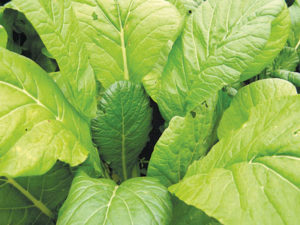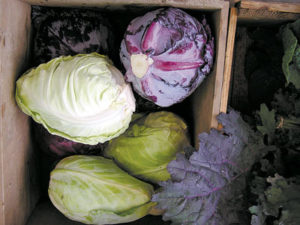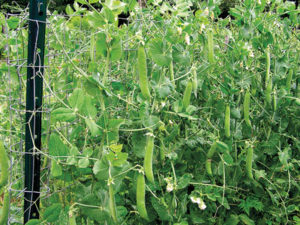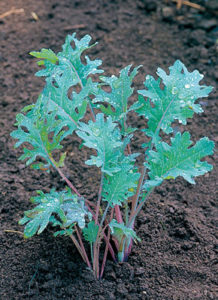 |
| Cabbage, tatsoi, peas and kale are among crops that can be started in summer to extend the growing and harvest season into fall. English photos. |
 |
 |
 |
| National Garden Bureau photo. |
By Roberta Bailey
There is a week in late July when I find myself wishing that I could stop time. The garden is perfect. Tomatoes are ripening, green beans, summer squash, zucchini and cucumbers are prolific. Creamy new potatoes and baby carrots overlap with late shelling peas in delicate perfection. Virtually everything I need for a simple feast is just a few feet away. I want to live in this paradise and to nap in sun-drenched mulched rows for months.
But the summer garden is a fickle entity, especially in Maine. One day a gardener is breathing in the heady scent of ripe raspberries in the hot sun; the next evening brings a chill to the breeze, the first whispers of autumn, goldenrod and frosts.
The summer garden is also the gateway to a longer fall harvest. Last summer was a great lesson in second, third and fourth plantings. Anywhere something died or went to seed, I planted another crop. As a result, the garden was lush and bountiful long into November with little added protection. I may not have had a lot of tomatoes, but I had great Asian greens, turnips, spinach and kale.
This summer my garden is smaller, but I hope that overlapping crops will increase its productivity and yield. When one crop has matured, I plan to fertilize and reseed or transplant another.
Some will be spur of the moment second plantings: Fluff the soil, add compost and sow some seed. More planning is needed if transplants are involved. I start fall broccoli seedlings about June 15, just when the greenhouse has emptied. Asian greens and lettuce seedlings lend well to summer transplant. For a steady supply of head lettuce, start a flat of lettuce seedlings every two to three weeks. Choose a cloudy or rainy day to set young transplants in the garden. The ground may need a generous pre-soak if the soil is dry and especially if no rain is forecast. Soak the seedlings as well. A fish emulsion watering helps with their transition. Transplant late in the day with as little disturbance to the seedling roots as possible so that the plant has the rest of the day, when the sun is low, and all night and the next morning to establish itself. Provide shade if needed. Lettuce does well in the partial shade of sunflowers or tall plants, even trees. I plant my July lettuce under a plum tree on the edge of the garden.
The first ground to open up may be from early plantings of spinach, lettuce or mesclun. As this is still early in the season, many crops can follow, from fall broccoli to carrots, short season cabbage, Asian greens, kale or collards. Last year, I added a little compost and a sprinkling of organic fertilizer and seeded pickling cucumbers. When a later planting of lettuce bolted, I seeded ‘Masai Haricot Vert’ green beans. Four successive plantings of 2- to 6-foot rows each of green beans provided tender beans until frost.
Herbs are good for filling small spaces that open up. Cilantro bolts quickly and can be seeded every two or three weeks to ensure a fresh supply for summer salsas. Basil and dill can be seeded until late July.
Radishes, scallions, radicchio, chervil, turnips, short season carrots and kohlrabi can be sown until mid-August. My favorite exciting new vegetables are ‘Hakurei’ and ‘Oasis’ turnips. They are small, fast growing white turnips that are sweet and tender – a bit like a radish but not hot. They can be harvested from marble to baseball size without becoming fibrous. We ate them all summer as a sliced snack. An August sowing in the former garlic patch fed us with ‘Oasis’ turnips well into November. I ate many of them right in the garden, the true measure of a great vegetable.
The garlic patch, once harvested, presents other opportunities. My patch often turns into a fall garden that later gets covered by a small hoophouse. I pull back the mulch to make each row and fertilize according to the needs of the crop. Fall spinach planted before mid-August will produce dinner plate sized leaves. Later plantings rarely size up as well. Kale, collards, winter hardy lettuce, turnips, short season kohlrabi, Asian greens, arugula and cilantro all thrive in the fall. If you plant garlic rows 1 to 1 1/2 feet apart, consider planting fall peas between the rows. I plant peas the first or second week of July (no later) and they are up when the garlic is pulled. Voila, an instant pea patch. The transition always makes me marvel.
Fall broccoli plantings need to be started in mid-June. The young seedlings can fill in where early peas go by or where any row opens up. Sometimes I space my early cauliflower extra wide and set young fall broccoli between each plant. Cauliflower plants get pulled as they mature, leaving space for the growing broccoli. Be sure to fertilize well or sidedress the broccoli as it grows.
As mentioned, Asian greens such as tatsoi, Chinese cabbage, bok choi and pak choy, mustards, ‘Toraziroh’ and ‘Maruba Santoh’ thrive in late summer and fall. Flea beetles are often less of a problem, although many gardeners cover these plantings row cover for complete protection. Many varieties are cold hardy and can be picked well into November with just row cover for protection.
If more space opens up than you can possibly use, sow a cover crop. I sow buckwheat until mid-August. After August, I sow oats. If ground is available very late, I sow rye – but only in areas that dry early in the spring. Rye grows quickly in spring and has a sturdy root system, which makes it difficult to till or readily break down. Oats winter kill and can be a nice spring mulch or good source of organic matter when tilled into the ground.
So the summer garden with her rosy fingers of dawn slides into the fall garden. And the fall garden quickly turns to winter. If we are lucky, those summer plantings will still be offering us greens, so frozen that they can shatter when being picked, but, when thawed, are just as firm and all the sweeter.
About the author: Roberta Bailey lives in Vassalboro and is a long-time writer for The MOF&G.
This article was originally published in The Maine Organic Farmer & Gardener. For planting dates, view MOFGA’s seed planting calendar. Interested in more gardening resources? Sign up for MOFGA’s Gardener Newsletter.
